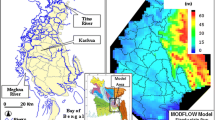Abstract
The use of subsurface barriers can be suggested to harvest the underground flows during the dry seasons. Groundwater levels at the south of Shahrekord plain has fallen strongly because of immoderate discharge and decreased the quality of water by urban wastewater entrance. The solute transport modeling was conducted to evaluate the impact of subsurface dam construction on flow treatment and urban water quality using numerical simulation. The hydraulic conductivity and specific yield has been calibrated in both steady-state and transient conditions during 15 months over the time period 2007–2008. The southern outlet of plain was selected to study the simulation of underground dam then a horizontal-flow barrier set in this location with mean hydraulic conductivity about 0.5 m/day. The solute transport model was calibrated and verified by monthly measured data of nitrate concentration before and after the dam construction. Longitudinal dispersivity and distribution coefficient was estimated 5 and 0.0001, respectively. The results show that the central parts of aquifer are responsible for raising the groundwater levels in the measured piezometers located about 4.5 km in upstream with 13 km2 area on the upstream side of dam structure. Quality model predictions don’t show considerable difference in nitrate concentration.











Similar content being viewed by others
References
Ali I (2010) Locating suitable sites for constructing subsurface dams using GIS. Master Thesis. Department of Land and Water Resources Engineering, Royal Institute of Technology Sweden
Da Silva MSL (1998) Agricultural exploration on underground dams. Pesquisa Agropecuaria Brasileira 33(6):975–980
Ishida S, Kotoku M, Abe E, Fazal MA, Tsuchihara T, Imaizumi M (2003) Construction of subsurface dams and their impact on the environment 50(1):149–152
Ishida S, Tsuchihara T, Imaizumi M (2006) Fluctuation of NO3-N in groundwater of the reservoir of the Sunagawa Subsurface Dam Miyako Island, Japan. Peddy Water Environ 4:101–110
Ishida S, Tsuchihara T, Yoshimoto S, Imaizumi M (2011) Sustainable use of groundwater with underground dams. Japan Agricult Res Quart 45(1):51–61
Lalehzari R (2008) The effect of wastewater recharge on nitrate distribution in Shahrekord aquifer using MT3D model. M.Sc. Thesis. Shahrekord University, p 130
Lalehzari R, Tabatabaei SH, Kholghi M (2010) Hydrodynamic coefficients estimation and flow treatment prediction in Shahrekord aquifer using PMWIN model. Fourteenth International Water Technology Conference, Cairo
Lalehzari R, Tabatabaei SH, Kholghi M (2013) Nitrate transport simulation in groundwater using MT3D model in wastewater seepage condition. Int J Environ Sci Technol 10:1367–1376. doi:10.1007/s13762-013-0213-4
McDonald MG and Harbaugh AW (1988) Modflow, A modular three-dimensional finite difference ground-water flow model, U. S. Geological Survey, Open-file report, pp 83–875, Chapter A1
Milanovic PT (1988) Artificial underground reservoirs in the karst experimental and project examples. IAH 21st Congress, Gulin
Milanovic PT (2004) Water resources engineering in Karst. CRC Press, UK, pp 195–213
Misaki T (2004) Technical reference for effective groundwater development. Japan, Japan Green Resources Agency, p 325
Onder H, Yilmaz M (2005) Underground dams, A tools of sustainable development and management of groundwater resources. Eur Water 11(12):35–45
Raju NJ, Reddy TVK, Munirathnam P (2006) Subsurface dam to harvest rainwater-a case study of the Swarnamukhi River basin, Southern India. Hydrogeol J 14:526–531
Tabatabaei SH, Lalehzari R (2009) Determination of the contaminant sources by mapping tools in Shahrekord aquifer. International Groundwater Symposium, Thailand, Iran
Tabatabaei SH, Lalehzari R, Nourmahnad N, Khazaei M (2010) Groundwater quality and land use change (A case Study: Shahrekord aquifer, Iran). J Res Agric Sci 6:39–48
Tayari A, Shamsaei A (2006) Analysis of effective parameters on water head over the underground dams and an innovative methodology for estimation of it. J New Agric Sci 2(3):87–102
Telmer K, Best M (2004) Underground Dams: a practical solution for the water needs of small communities in semiarid regions. TERRA 1(1):63–65
Yoshimoto S, Tsuchihara T, Ishida S, Imaizumi M (2013) Development of a numerical model for nitrates in groundwater in the reservoir area of the Komesu subsurface dam, Okinawa, Japan. Environ Earth Sci 70(5):2061–2077
Zheng C (1990) MT3D, A modular three-dimensional transport model for simulation of advection, dispersion and chemical reactions of contaminants in groundwater systems, Report to the U.S. Environmental Protection Agency, p 170
Acknowledgments
The authors wish to thank Regional Water Company and Water and Wastewater Company for providing some of data.
Author information
Authors and Affiliations
Corresponding author
Rights and permissions
About this article
Cite this article
Lalehzari, R., Tabatabaei, S.H. Simulating the impact of subsurface dam construction on the change of nitrate distribution. Environ Earth Sci 74, 3241–3249 (2015). https://doi.org/10.1007/s12665-015-4362-2
Received:
Accepted:
Published:
Issue Date:
DOI: https://doi.org/10.1007/s12665-015-4362-2




